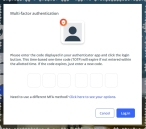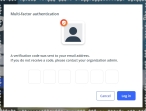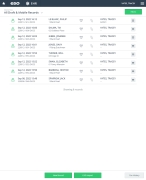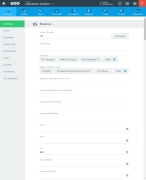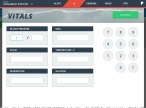Record the top six vitals
Assessing the patient's vitals is a critical step in determining what treatments the patient should receive. You can quickly record the most-important six vitals when examining the patient, without going into the level of detail available on the Vitals tab.
-
 (If you have not done so already) Access the EHR module in the ESO Suite.
(If you have not done so already) Access the EHR module in the ESO Suite.
-
Do one of the following.
-
(If you are already working in the ESO Suite) Click the Home icon in the upper left corner of the screen.
-
 (If you have not yet logged in) Log in to the ESO Suite.
(If you have not yet logged in) Log in to the ESO Suite.
-
In a web browser, go to https://www.esosuite.net/EsoSuite.
The ESO Suite login screen appears.
-
Enter your user name, password, and agency name, then click Let's Go.
If MFA is enabled, the Multi-factor authentication dialog box appears, displaying one or more methods you can use to verify your login credentials. The number of methods that appear in the dialog box depends on what MFA methods your ESO Suite administrators enabled in the Admin module.

Click graphics
to open them.Information on enabling MFA and specific MFA methods is available in the Admin module online help, in Configure multiple-factor authentication.
Note: If your ESO Suite administrators have disabled MFA ("opted-out"), this dialog does not appear.
-
(If the Multi-factor authentication dialog box appears) Depending on which buttons appear in the dialog box, verify your login in one of the following ways.
 With an authenticator application.
With an authenticator application.
-
Click MFA verification via authenticator app.
The dialog box updates with boxes for entering the numbers of the authentication code, and the ESO Suite sends an authentication code to the authenticator application installed on your device.
-
Open your authenticator application and note the authentication code currently displayed.
-
Enter the authentication code displayed in the authenticator application.
-
Click Log In.
 With a text message (SMS).
With a text message (SMS).
-
Click MFA verification via SMS.
The dialog box updates with boxes for entering the numbers of the authentication code, and the ESO Suite sends an authentication code to the phone number recorded in your PM records and identified with MFA codes.
-
Enter the authentication code sent to your MFA-registered phone number.
-
Click Log In.
 With an email message.
With an email message.
-
Click MFA verification via email.
The dialog box updates with boxes for entering the numbers of the authentication code, and the ESO Suite sends an authentication code to your agency or department email address, recorded in your PM records.
-
Enter the authentication code sent to your agency or department email address.
-
Click Log In.
-
-
The ESO Suite landing screen appears.
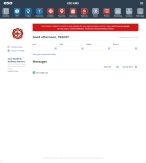
Click graphics
to open them.Note: If MFA is enabled, you can access and manage your MFA options through the PM module, on the Settings > Account page, as described in Manage a user account. If your agency or department has enabled MFA but has not purchased the full-featured version of the PM module, you can access your own MFA settings by clicking Change my Multi-Factor Authentication settings on the landing screen, then using the Settings > Account page that appears. If your agency has not enabled MFA, the Change my Multi-Factor Authentication settings link does not appear on the landing screen.
-
-
On the top side of the home screen, click EHR.
Tip: If your screen or browser window is too narrow to display all your agency's ESO Suite module icons, an options icon appears on the right side of the icon bar. If you click the options icon, a menu appears containing additional module icons.
The EHR screen appears, displaying a list of patient records in the EHR module. The most-recent records appear at the top of the list.
Different record status icons can appear in the list.
Icon Status Unlocked/DraftThe patient record exists in the ESO Suite database, and all crew members listed in the patient record may edit all fields in the record. ESO Suite administrators and personnel with security roles of either
EHR SupervisororEHR Managercan edit non-clinical fields.MobileThe patient record exists on the mobile device, and has not been synchronized with the ESO Suite database. ESO Suite administrators, personnel with security roles of either
EHR SupervisororEHR Manager, and all crew members listed in the patient record can only access a print view of the record.Once the Mobile record synchronizes with the ESO Suite database. the record reflects its current status.
LockedThe patient record exists in the ESO Suite database, and is locked. Only non-clinical fields can be edited by crew members listed in the patient record, ESO Suite administrators and personnel with security roles of either
EHR SupervisororEHR Manager.
-
-
 (If you have not done so already) Add a new patient record, or search for the existing patient record you want to work with.
(If you have not done so already) Add a new patient record, or search for the existing patient record you want to work with.
Information on adding or opening a patient record is available in Add a patient record and Search for a patient record.
The patient record opens and displays the Incident tab, with the Response bookmark selected in the left pane. Fields appear in the right pane for specifying basic information about the incident
If you manually created a new patient record, the Incident Number and State Tracking Number fields populate automatically with ESO Suite-assigned values. You must enter data in all other required fields.
If you imported data from a CAD system, the Incident Number field populates with the data from that source. Other fields in the EHR module may also populate from these sources, depending on what data was recorded in them before the data was imported into the EHR module.
-
In the upper right corner of the page, click the red shortcuts menu.
Note: In the EHR module, this menu is referred to as the "Quick Treats" (quick treatments) menu.
The contents of the menu appears to the left, across the top of the page.
-
Click Vitals.
The Vitals page appears.
-
 Enter the vitals information.
Enter the vitals information.
-
In Blood Pressure, in the two fields, type or use the number pad to enter the patient's systolic and diastolic blood pressures, respectively.
Blood pressure measures the force in which blood is pushed against artery walls when your heart contracts and relaxes. Systolic blood pressure (the top number) is the pressure inside the artery when the heart pumps blood to the body. Normal systolic blood pressure is less than 120. Diastolic blood pressure (the bottom number) is the pressure inside the artery when the heart is at rest. Normal diastolic blood pressure is less than 80.
-
In SpO2, type or use the number pad to enter the patient's oxygen saturation.
SPO2 (oxygen saturation) is a measurement of how much oxygen your blood is carrying as a percentage of the maximum it could carry. EtCO2 (carbon dioxide) is the exhaled end-tidal carbon dioxide at the end of an exhaled breath. For a healthy individual, the normal value should be between 96% to 99%.
-
In Pulse, type or use the number pad to enter the patient's pulse rate.
A pulse measures how many times the heart beats per minute. A healthy resting heart rate is between 60 and 100 beats per minute.
-
In Temperature, type or use the number pad to enter the patient's current temperature in Fahrenheit.
Temperature is a measure of the body's ability to generate and dissipate heat. The average body temperature is 98.6 F (37 C), but can range between 97 F (36.1 C) and 99 F (37.2 C) or more. Older people generally have lower body temperatures than younger people have.
-
In Respiration, type or use the number pad to enter the patient's respiration rate.
Breathing, or respiration, is the process of drawing into the body oxygen and expelling carbon dioxide from the body. The respiration rate is the number of breaths a person takes per minute. Normal respiration rates for adults range from 12 to 20 breaths a minute.
-
In Glucose, type or use the number pad to enter the amount of sugar found in the patient's blood stream.
Glucose, or blood sugar, is the main sugar found in your blood. It comes from the food you eat, and is your body's main source of energy.Normal blood glucose level (while fasting) ranges within 70 to 99 mg/dL (3.9 to 5.5 mmol/L). Higher ranges could indicate pre-diabetes or diabetes.
-
-
In the upper right corner of the page, click Add Vitals.
The EHR module automatically adds the information you entered in the vitals shortcut to the information on the Vitals tab.
-
(Optional) At the top of the page, click the Vitals tab.
The contents of the Vitals tab appear, listing shortcut vitals after any vitals recordings previously performed on the patient.
Information on all the features available on the Vitals tab is available in Add, edit, or delete vitals information.

